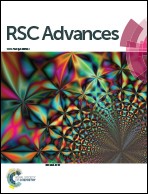Synthesis and characterization of Co(ii) and Fe(ii) peptide conjugates as hydrolytic cleaving agents and their preferential enantiomeric disposition for CT-DNA: structural investigation of l-enantiomers by DFT and molecular docking studies†
Abstract
Enantiomeric Boc L/D-valine derived peptide conjugate complexes of Co(II) L/D-1 and Fe(II) L/D-2 were synthesised and thoroughly characterized by spectroscopic techniques, elemental analysis, molar conductance and magnetic moment measurements. Peptide complexes L/D-1 and L/D-2 were titrated with CT-DNA by employing various biophysical methods viz., UV-vis, fluorescence and circular dichroic studies and viscosity measurements to envisage their binding mode and binding strength; the experimental results revealed strong preferential disposition of L-enantiomeric complexes via electrostatic binding mode with DNA helix. The structures of L-1 and L-2 were further optimized by applying DFT and molecular docking studies to validate their interaction by electrostatic bonding with DNA. Since L-enantiomers exhibited greater binding propensity than D-enantiomers, therefore, the cleavage efficiency of L-1 and L-2 with pBR322 DNA was evaluated by gel electrophoretic assay. L-Enantiomers of both Co(II) and Fe(II) complexes were found to be efficient cleaving agents and cleavage reactions were mediated by hydrolytic pathway, which were further validated by religation experiments using T4 ligase enzyme.


 Please wait while we load your content...
Please wait while we load your content...